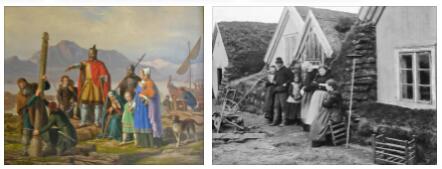History
Vikings settle in Iceland
For a long time Iceland was almost deserted and due to its location was settled late. There are traces from the 7th century. Gardar Svavarsson came from Sweden in 870 and spent the winter here. He is considered the discoverer of Iceland. He named the island Gardarsholm. Flóki Vilgerdarsson is said to have given Iceland its name when he saw pack ice: Eisland.
But Ingólfur Arnarson was the first settler to stay permanently. He decided to leave his home in Norway when there was an argument there and settled in Iceland with his family around the year 874. Other chief families from Norway followed him. By 930 the habitable land was divided.
Iceland as a Free State (930-1262)
With the Althing, one of the first legislative assemblies in Europe was established in Iceland this year. Once a year the Goden met, passed laws and spoke justice. There were 36, later 39, of these Goden, a kind of chief or ruler. The Gothi had inventory into submission by the Norwegians in the 1262nd
During this time the Vikings made important voyages of discovery. They came to Greenland and were the first to discover America long before Columbus landed there. So Erik the Red settled on Iceland, his son Leif Eriksson landed from there in the year 1000 in North America. In the same year Christianity was declared the state religion.
After a long period of peace, from 1180 onwards there were disputes between several ruling families. The power of the Norwegian kings grew and they increased their influence in Iceland until finally a duke appointed by Norway took over power in the country in 1262.
Norwegian rule (1262-1380)
Under the Norwegian rule, the Althing was dissolved and the gods disappeared. The Icelandic jurisprudence has been replaced by the Norwegian. The power of the Church, which had long rested with the secular Gods, now grew. Property on which churches were built now became the property of the church. That could increase her wealth so much. Icelanders were usually not appointed as bishops and so they did not often act for the benefit of the local population.
In 1341 the volcano Hekla erupted so violently that many farms had to be abandoned and famine occurred. As in the rest of Europe, plague outbreaks occurred in the 14th century.
Danish rule (1380-1944)
In 1380 Norway came under Danish rule and with it Iceland. The rule of the Danes over Iceland lasted more than 500 years. The Danes also controlled the trade. From 1397 Iceland was part of the Kalmar Union. In 1552 the Reformation took hold under pressure from the Danish king. The plague and smallpox also claimed many deaths during this period and in the 18th century. In 1783 the volcanoes of the Laki crater erupted for several months, killing other Icelanders.
While Norway fell to Sweden in 1814, Iceland remained Danish. In 1874 Iceland adopted its own constitution. In 1904 Denmark granted Iceland internal autonomy. It also gained external independence in 1918, but the Danish king remained the Icelandic head of state until 1944. Then the Republic of Iceland was established.
Iceland as an independent republic (since 1944)
Iceland joined the UN (United Nations) in 1946 and the OECD (Organization for Economic Co-operation and Development) in 1948.
In the 1950s and 1970s the so-called Cod Wars broke out with Great Britain. The Icelanders expanded their fishing zone after many fishing grounds were overfished. Iceland eventually prevailed and now has a 200-mile fishing zone.
In 2008 there was a financial crisis that brought Iceland to the brink of national bankruptcy. The country ran out of money. The economy has been recovering since 2011. There are different views on possible accession to the EU.
Christmas in Iceland
According to COUNTRYAAH, Iceland is one of the smallest countries in Europe by population. As of 2021, Iceland has a total population of 358,769.
How do you celebrate Christmas in Iceland?
Christmas is called Jól in Icelandic. Christmas has only been celebrated with a Christmas tree in Iceland since the 1960s. Before that there were hardly any trees on the island as they had all been cut down. Today the trees are brought from Sweden, some of which are grown by planting them themselves.
On Christmas Eve, i.e. December 24th, Christmas is rung in by numerous bells at 6 p.m. A festive meal is part of Christmas. This can be a smoked pork loin, a rock ptarmigan, fish or smoked lamb (Hängikjöt). For dessert there is almond rice porridge. There is a whole almond in a bowl. If you find it, you will get a little present!
Laufabrauð is also part of the Christmas season. Translated, this means something like leaf bread, but it is often called snowflake bread. By cutting the thin flatbreads, great decorations are created that sometimes look like snowflakes.
Who are the Jólasveinar?
The 13 Christmas journeyman in Iceland are something very special. They are called Jólasveinar. But everyone also has their own name, such as Stúfur or Pottaskefill. The journeymen do all sorts of jokes and steal food! Everyone has a special preference: one licks out the pots, the other steals candles, one slams doors and another looks in through the window with big eyes!
Every day between December 12th and 24th, one of them comes to the people from the mountains. There are also calendars that tell a story every day. After Christmas Day they then disappear one after the other. The last journeyman disappeared on January 6th. Today, however, the Christmas journeyman have often taken on a role more than Santa Claus as we know him. So they bring presents and wear red clothes.
